Recent Posts
-
Real Crimes and the Coming Violence
September 6, 2025
-
Whither Modern Life?
June 27, 2025
-
What the Hell
June 18, 2025
-
As Darkness Engulfs Us
April 6, 2025
-
AI, Risk, and Work
January 17, 2025
-
“Things Are in the Saddle, and Ride Mankind”
December 29, 2024
-
Forgotten Futures in Seattle
December 12, 2024
-
Autocracy Defeats Neoliberalism
November 14, 2024
-
History… We’re Soaking in It!
October 2, 2024
-
A Numbing Spectacle
September 22, 2024
|
 An alpine glacier as I flew towards Milan. I just enjoyed a get-away to Europe for almost two weeks. I spent three days with Mona at her place in southern Switzerland where I hadn’t been for 20 years, and another three days in a small town in the Italian Alps with my old friend Giovanni, ending with a fun trip to the thermal baths and spa at San Pellegrino… Our politics have drifted far apart, but we still enjoy each other even when we argue for hours. The journey ended yesterday with Adriana and family in Lithuania for a celebration of her sister’s wedding and new baby. It was an odd trip to be sure!
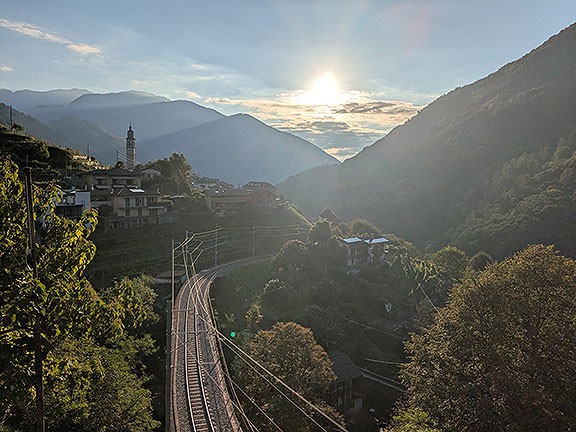 Sunrise over Intragna, Switzerland. I don’t go too long without the darkness of the Gaza genocide entering my mind. How is it that such a large majority of the world stands clearly against this horror and demands its immediate cessation, and yet the U.S. and Israel keep killing, keep doing what they are obviously doing—slaughtering, starving, and destroying the two million Palestinians in Gaza, and now beginning to expand that extermination campaign to the West Bank? How do most European powers and the propaganda organs masquerading as independent media keep supporting this? “Never again” is an insulting phrase now, when those who have shouted this the loudest and longest are now the ones carrying out precisely the ‘again’ that was never to be allowed by the world.
My words and thoughts on this are irrelevant, I know. I add my drop of water to the sea of opposition. I wish I had the power to affect the course of events. I wish I lived in a world where justice and fairness meant something. Of course in the U.S. it has always been proclaimed—and consistently violated in favor of power and money. The Trumpists have dropped any pretense about the rule of law, and are engaged in the fastest ever looting of the country in its long sordid history of plunder and rapacious exploitation. Not to mention their ramping up of organized thuggish violence in the streets combined with a rising number of disappearances. Are death squads about to start in the U.S.? Hard to believe it could get worse, but every day it does. It remains to be seen if there will still be elections, and if they will be free enough to take power away from these people.
We are well down the road to open, bald-faced fascism. The ICE troops being recruited and deployed, backed up by active military and National Guardsman, seem to be the kind of “good Germans” that made the Nazi death camps run. One protest sign I saw go by on social media asked simply “What Trump Order Will You Disobey?” That’s the question that hangs over us now as a Sword of Damocles. If the everyday soldiers being used as theatrical props right now don’t want to become actual murderers and pawns or even unwilling protagonists of this neo-fascist takeover, they’ll have to refuse to play along, and further, turn on their commanders who haven’t had the spine to stand up to these illegal orders. Mass protest will grow more difficult if and when they start savagely beating people for standing quietly with a sign, or chanting their opposition to this madness, or when they fill the expanding privately owned jails with people who turn their cameras on the illegal body snatchers… and so on.
And mass protest has felt so impotent for so long that it’s hard to muster the enthusiasm to turn out. At least since the Bush/Cheney crowd, and probably back to Reagan’s people, the strategy has been to simply ignore protest and pretend it doesn’t exist. The corporate media has generally gone along with this, reinforcing the power of the authorities to determine what is “news” and what isn’t. So marching around yelling at buildings has become a painfully empty ritual most of the time, at best amplified on social media reproducing its own bubble. There are occasional breakthroughs of course, and that’s why some people still turn out, in the hopes that it will have a wider impact. The Tesla Takedown protests did drive sales down worldwide and put a dent in Elon Musk’s aura, if not his wealth. Twenty-five years ago the WTO protest in Seattle did stop them from making many horrible trade deals that were on the table at the end of the 20th century. So what will we do now?
Continue reading Real Crimes and the Coming Violence
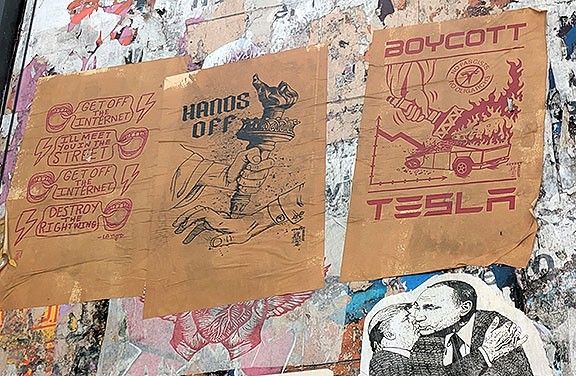 Recent additions to Democracy Wall on Valencia Street. I’m immersed in reading all the time, and much of what has attracted my interest in the past year or two are books that try to explain how the structure of capitalism is mutating during this violent, chaotic and barbaric time. No doubt we left Fordism behind decades ago, the system of blue-collar factory work with steady jobs and union contracts, with a growing white-collar administrative sector equally protected by lifetime employment in major corporations. After a half century of neoliberalism (not really a proper category but let’s use it to denote the period since the late 1970s as a place-holder for now) that saw the conclusion of the Soviet-U.S. Cold War, followed by the steady disintegration of the liberal state, we find ourselves between the rock of neo-fascist revanchism and the squishy nothingness of what used to be social democratic liberalism.
Further afield, but closer than we think, is the Chinese model, which from a certain point of view looks like a model that has growing appeal for the authoritarians riding Trumpism. Modern China is a state-organized and managed system that allows private capital to pursue rapid, ecologically devastating industrial modernization without gaining political power, that maintains tight control of politics and suppresses overt dissent, and uses advanced smart-phone technology for panoptic surveillance that analyzes private behaviors and preferences almost in real time. Vast military and security bureaucracies guarantee state power for those who sit at the top of the political system, and no room is made for course correction through democratic contestation or public debate. This is remarkably close to what it seems the people around Trump would like to construct with their Gestapo-like masked ICE thugs randomly sowing terror through abductions and disappearances, and campaigns to silence political opposition from strident student activists to weak-tea opposition politicians to conservative judges who adhere to the rule of law.
Sarah Wynn-Williams is a refugee from years of earnestly believing in and working for Facebook. A New Zealand citizen and former diplomat, she ingratiated herself with the company around 2010 and became one of the inner circle, working hard to get Mark Zuckerberg and other executives into direct negotiations with political leaders around the world. Her book, Careless People: A Cautionary Tale of Power, Greed, and Lost Idealism (Flatiron Books, NY: 2025), has been published but her ability to promote it was blocked by having signed non-disclosure agreements on her way out of the company when she finally quit a few years ago. It manages to be an interesting read even if her puppy-dog earnestness throughout the first 2/3 of the book is painfully naive and embarrassing. She finally grows disenchanted after the umpteenth time that the executive team (including Zuckerberg himself and the detestable Sheryl Sandberg) does something execrable, and by the last chapters she starts making revelations. Turns out Facebook gave their entire corporate approach to the Chinese Communist Party (CCP), perhaps illustrating my contention that there is some kind of convergence happening even if there’s an official belligerence and hostility being stoked by Biden, Trump and other nationalists.
As I read through page after page, I see the sort of briefings that would warm the hearts of every government I work with. We never share this type of information, and believe me they’ve asked. But here are detailed explanations of precisely how the technology functions, of algorithms and photo tagging and facial recognition. All the secrets of the trade that I thought would never be revealed to anyone outside Facebook. Facebook is providing engineers to demonstrate, offering ideas on how to adapt the settings to meet the Chinese government’s needs. It’s white-glove service for the CCP. The ugly fact is that these are many of the things Facebook has said are simply impossible when Congress and its own government have asked—on content, data sharing, privacy, censorship, and encryption—and yet its leadership are handing them all to China on a silver platter. (p. 313)
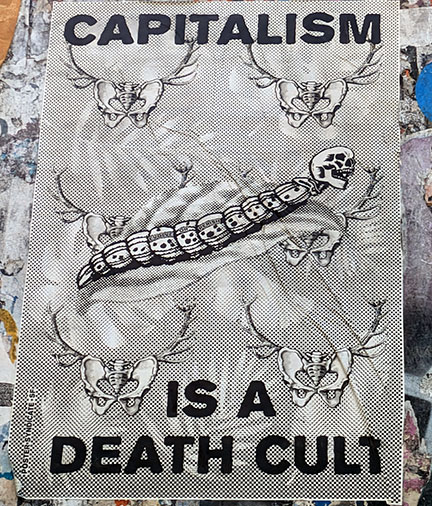
Can it be said that we are at the end of capitalism itself? I don’t think so. But there are interesting writers who argue that the capitalist system is changing how it reproduces itself in ways that might undercut its survival as a coherent system of political economy. The one-time finance minister of Greece during its left-wing electoral success a decade ago, Yanis Varoufakis, has written an interesting book titled TechnoFeudalism: What Killed Capitalism (Melville House, Brooklyn, NY: 2024) in which he argues that, using the vast sums printed and distributed by central banks in the wake of the 2008 global collapse, and even more than that during the pandemic, cloud computing companies have grown into behemoths (Amazon, Google, Apple, Microsoft, Meta) by repeating a process that took place centuries ago in England. Back then, the actual land was enclosed and turned into private property by the royal barons of the monarchy. Today, the “cloudalists” as he calls them have enclosed the internet and made what should be owned in common their private property. But unlike previous owners of land and factories and other sources of private profit,
“cloud capital can reproduce itself in ways that involve no waged labor. How? By commanding almost the whole of humanity to chip in to its reproduction—for free!” (p. 82) … This is unparalleled. Workers employed by General Electric, Exxon-Mobil, General Motors or any other major conglomerate collect in salaries and wages approximately 80 percent of the company’s income. This proportion grows larger in smaller firms. Big Tech’s workers, in contrast, collect less than 1 percent of their firms’ revenues. The reason is that paid labor performs only a fraction of the work that Big Tech relies on. Most of the work is performed by billions of people for free. (p. 87)
Continue reading Whither Modern Life?
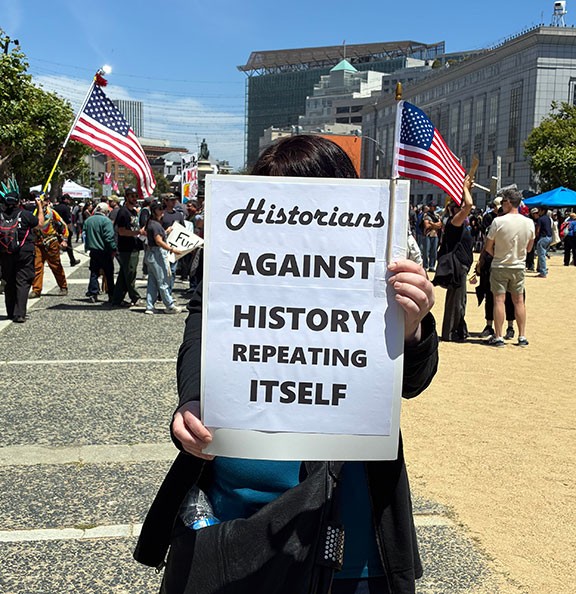 June 14, 2025, h/t Polly Marshall for sending me this photo while I was home with COVID. I’ve been extremely reluctant to write anything for months. We are drowning in bullshit. The maelstrom of AI-generated slop on all social media platforms is bad enough. But there’s also so many new independent journalists (no longer employed in real newsrooms) at substack, medium and other platforms clamoring for us to read (and donate to) them.
Makes you wish there was a decent newspaper where you could find a selection of these great writers regularly. Imagine a solid daily paper that honestly and critically covered the news, and that you could feel good about supporting. And it only cost a quarter every day! But there’s no such thing. The well-known newspapers are drastically overpriced and awful, full of propaganda and working to normalize this rapid further descent into barbarism. TV and cable shows are even worse. I still read some magazines, but these days I spend more hours reading books than anything else.
Podcasts are the place I find myself relying on for independent, thoughtful, in-depth coverage of things I can barely find in the printed press. And there are somewhere over 2 million podcasts now! How are you supposed to wade through all that? Who has time to puzzle it out? (Find my list at the end of this post.)
There’s such a shit-ton of words anywhere you care to look. Most of it is not worth a glance, while there are plenty of gems hidden here and there, to be sure. But ever more exasperated, I ask myself, what (and why) do I have to add to it? I’ve had the reasonable excuse that my father moving into assisted living at the end of February and requiring my regular presence at least two times a week, and sometimes more, has significantly altered the rhythm of my life. I haven’t had as much time as usual to ruminate and write. But I also haven’t felt called to do much writing either. And yet, here I am!
I don’t have any unique insight into the fascist efforts to remake the government to serve them, although I am going to write a bit about the deeper philosophical ideas that have given them space to work. We’re all watching in real time, to varying degrees resigned or stunned, enraged or skeptical, about the radical right effort to wreak havoc. Judges are blocking things at an unprecedented rate, but it’s like watching the little Dutch boy put his fingers in the dike that keeps springing new leaks. Or a not-funny game of Whack-a-mole. And if it is a systematic program to delegitimize the rule of law, what judicial decisions are going to halt the entitled and pointed provocations of misanthropic malevolence?
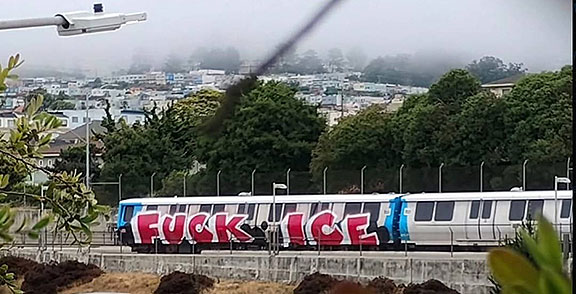 Don’t see BART cars graffiti’ed too often, but when you do!…  June 14, 2025 Literally millions of people are doing their civic-minded best to obstruct and impede the assholes, whether the new American Gestapo operating as ICE, or the old familiar thugs at the FBI or local police. Kudos to the folks in LA who have stood strong. Locally we have seen hundreds surrounding ICE facilities in the past days to block their cruel efforts to snatch and deport innocent people. Last Monday about 2500 gathered at the nearby BART plaza and marched up Mission Street in a show of solidarity with Los Angeles and a willingness to stand up to the government. I went down with COVID the next evening and am still laid up as I write this a week later.
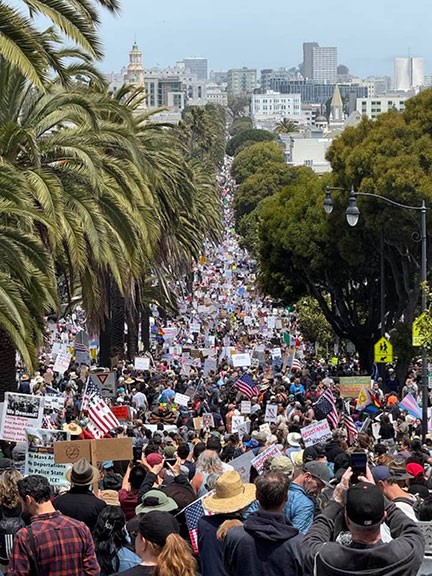 Great shot north on Dolores Street, June 14, 2025… Photo: Sue Bee Tens of thousands marched in the sunny “No Kings” protest here in SF, and many millions more in cities and towns everywhere. All good. But none really touches the levers of political and police power that they’re using to rip up the meager social safety net, and criminalize countless people just trying to live their lives. It would be ironically funny to see libertarian anti-government blowhards becoming authoritarian control-freaks at the head of the state if it weren’t so harmful to so many. These are deeply warped people, many of whom have now embraced the bizarre assertion that empathy is a sign of weakness. These damaged people have lost their basic humanity and they’re trying to pretend that’s a good thing. How did we get to the place where some of the worst people, filled with resentment and hatred and fear, have grabbed all this power?
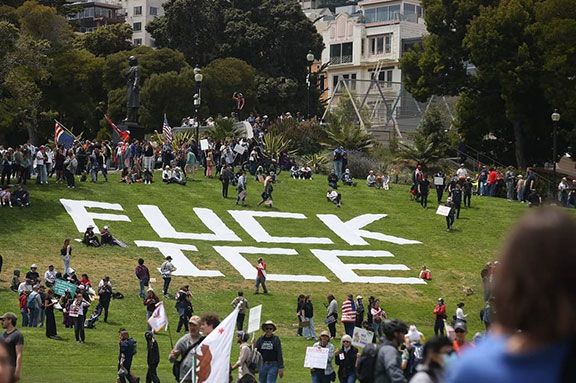 Dolores Park, I always knew you were smart… Continue reading What the Hell
|
Hidden San Francisco 2nd EDITION!

NEW 2nd EDITION NOW AVAILABLE!
Buy one here
(Pluto Press, Spring 2025)
|




















